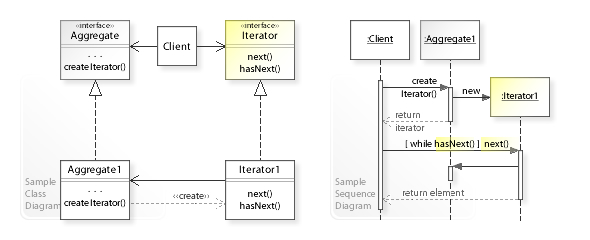Iterator Pattern
Let’s review three other commonly used software design patterns. These are either patterns that we’ve seen before, or ones that we might end up using soon in our code.
Iterator Pattern
The first pattern is the iterator pattern. The iterator pattern is a behavioral pattern that is used to traverse through a collection of objects stored in a container. We explored this pattern in several of the data structures introduced in earlier data structures courses such as CC 310 and CC 315, as well as CIS 300.
In it’s simplest form, the iterator pattern simply includes a hasNext() and next() method, though many implementations may also include a way to reset the iterator back to the beginning of the collection.
Classes that use the iterator can use the hasNext() method to determine if there are additional elements in the collection, and then the next() method is used to actually access that element.
In the examples below, we’ll rely on the built-in collection classes in Java and Python to provide their own iterators, but if we must write our own collection class that doesn’t use the built-in ones, we can easily develop our own iterators using documentation found online.
In Java, classes can implement the Iterable interface, which requires them to return an Iterator object. In doing so, these objects can then be used in the Java enhanced for or for each loop.
import java.lang.Iterable;
import java.util.Iterator;
import java.util.List;
import java.util.LinkedList;
public class Deck implements Iterable<Card> {
List<Card> deck;
public Deck() {
deck = new LinkedList<>();
}
@Override
public Iterator<Card> iterator() {
return deck.iterator();
}
public int size() {
return this.deck.size();
}
}Here, we are making use of the fact that the Java collections classes, such as LinkedList, already implement the Iterable interface, so we can just return the iterator from the collection contained in our object. Even though it is not explicitly required by the Iterable interface, it is also a good idea to implement a size() method to return the size of our collection.
With this code in place, we can iterate through the deck just like any other collection:
public class CardGame{
public static void main(String[] args) {
String deckType = "Standard 52";
Deck cards = DeckFactory.getInstance().getDeck((DeckType.valueOf(deckType)));
for(Card card : cards) {
// do something with each card
}
}
}In Python, we can simply provide implementation for the __iter__() method in a class to return an iterator object, and that iterator object should implement the __next__() method to get the next item, as well as the __iter__() method, which just returns the iterator itself. Python does not define an equivalent to the has_next() method; instead, the __next__() method should raise a StopIteration exception when the end of the collection is reached.
For the purposes of type checking, we can use the Iterator type and the Iterable parent class (which works similar to an interface).
from typing import Iterable, Iterator
class Deck(Iterable[Card]):
def __init__(self) -> None:
self._deck: List[Card] = list()
def __iter__(self) -> Iterator[Card]:
return iter(self._deck)
def __len__(self) -> int:
return len(self._deck)
def __getitem__(self, position: int) -> Card:
return self._deck[position]Here, we are making use of the fact that the built-in Python data types, such as list and dictionary, already implement the __iter__() method, so we can just return the iterator obtained by calling iter() on the collection.
In addition, we’ve also implemented the __len__() and __getitem__() magic methods, or “dunder methods”, that help our class act more like a container. With these, we can use len(cards) to get the number of cards in a Deck instance, and likewise we can access each individual card using array notation, as in cards[0]. There are several other magic methods we may wish to implement, which are described in the link above.
With this code in place, we can iterate through the deck just like any other collection:
from typing import List
class CardGame:
@staticmethod
def main(args: List[str]) -> None:
deck_type: str = "Standard 52"
cards: Deck = DeckFactory.get_instance().get_deck(DeckType(deck_type))
for card in cards:
# do something with each cardReference
See Iterator on Python Design Patterns for more details.
